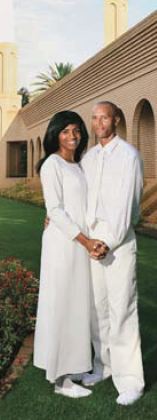
Most Mormon worship on Sundays is quite similar to the “low church” tradition of American protestantism. There is very little ritual; preaching and prayers are unscripted and spontaneous.
The temple endowment, however, is quite different. An endowment is a gift; it is not unusual, for instance, for a university to receive a monetary endowment from a wealthy contributor. Similarly, a Mormon temple endowment is a gift—not of money or worldly goods, but of knowledge and blessings. Unlike the spontaneous, relatively informal worship on Sunday, the endowment is rich with ritual and symbolism.
The endowment is essentially a sacred drama, somewhat similar to the passion plays of modern Christians or the miracle/mystery plays of medieval Christianity.
The endowment serves two broad purposes in Mormon theology:
- it teaches religious and moral principles;
- it is an ordinance: a physical act during which the participants make covenants with God.
The endowment is presented within a symbolic and dramatic framework. This framework discusses the creation of the world, the plan of happiness, and the role of Jesus Christ as Creator, Savior, and Mediator with the Father.
The endowment also dramatizes the return of the soul to God through obedience to God’s commandments and faithfulness to the gospel covenant offered by Jesus. This progression is represented by movement (either actual or figurative) from one room to another, culminating in the “celestial room.”
Placed at the top of each temple, the celestial room represents the peace, beauty, and reunion of God’s kingdom. As members progress through the ritual drama of the endowment, they are also physically moving “upward” in space, toward the abode of God and reunion with Him.
Promises and Covenants
The endowment also focuses on the necessity of obedience to God’s laws and the unity which must exist among believers. The covenants emphasize the need for increasing dedication to God and the service of his people:
- Obedience: one must first have faith, which is manifested by a willingness to obey God, even without irrefutable evidence;
- Sacrifice: faithful obedience leads us to sacrifice, in which we obey even though our obedience costs us something of value;
- Gospel: as we obey and sacrifice our own desires and needs, God reveals to us the gospel, the “good news” of his Son, which can save us if we continue to observe it;
- Chastity: participants covenant to reserve their sexual acts for marriage with their spouse. This manifests a willingness both to obey God and to sacrifice what may be deeply felt needs. Absolute fidelity in marriage is also a necessary prerequisite to a stable and happy community—families and communities will not be joined together in trust and love if marital bonds are not honored.
- Consecration: the goal of every Mormon is to become totally committed to God and to make His will our own (Luke 22:42). This can only happen as believers become one in Christ (John 17:20-23). This unity of heart and mind between God and His people fulfills the Mormon dream of Zion: a holy city in which all “were of one heart and one mind, and dwelt in righteousness; and there was no poor among them” (Moses 7:18). Mormon doctrine calls this complete dedication and commitment “consecration.”
In short, those who participate in the endowment “covenant and promise to observe the law of strict virtue and chastity, to be charitable, benevolent, tolerant and pure; to devote both talent and material means to the spread of truth and the uplifting of the [human] race; to maintain devotion to the cause of truth; and to seek in every way to contribute to the great preparation that the earth may be made ready to receive…Jesus Christ” (Talmage, 1968, p. 84).
Presentation of the Endowment

The endowment was originally performed with assigned members (known as temple workers) serving as actors. With the advent of motion picture recording, many temples switched to a video presentation of the endowment. Most temples today use this method; a few continue to utilize live actors. Unlike most Mormon worship, the endowment works from a fixed text. Changes to the endowment text have been approved from time to time by Church leaders to best communicate the principles and doctrines being taught. While the presentation of the endowment may be altered according to cultural needs and circumstances, the teachings and covenants communicated by the endowment remain constant.
The Endowment is Sacred
Mormons regard the endowment as sacred. As such, they do not discuss its specifics outside of the temple—even with other Mormons. This reticence is not intended to be mysterious or offensive—instead, Mormons regard these teachings and promises as exceptionally sacred. They are mindful of Jesus’ command not to parade that which is holy before the world.
Remembering the Endowment
Like being baptized, Mormons only endowed once for themselves. However, members return to the temple to experience the endowment again, doing so in behalf of deceased persons, just as they do for vicarious baptism and marriage.
Those who have been endowed wear a special type of underwear called temple garments.
To learn more:
- Alma P. Burton, “Endowment,” Encyclopedia of Mormonism, edited by Daniel H. Ludlow, (New York, Macmillan Publishing, 1992), 2:454-456.
